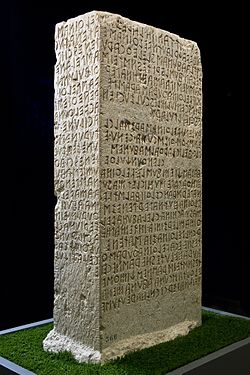Etruscan civilization
The Etruscan civilization was a culture in ancient Italy that lasted from about 900 BC to 27 BC. The Etruscans ruled Rome until 396 BC.
Etruscan civilization | |||||||||
|---|---|---|---|---|---|---|---|---|---|
| 900 BC–27 BC | |||||||||
 | |||||||||
| Status | City-states | ||||||||
| |||||||||

People living in this civilization called themselves Rasenna. The Romans called the people Etrusci or Tusci. The Ancient Greeks called them Tyrrhenoi or Tyrrsenoi.
The Etruscan civilization began in pre-history. They lived in an area which included modern Tuscany, but was larger. At their height, they had three confederacies (like modern states): Etruria, Latinum and the Po Valley, and Campania.
History
The Etruscans mined metals like copper and iron. They became rich and powerful and travelled around the Mediterranean Sea. Politics was based on the small city and probably the family unit.
In their heyday, the Etruscan elite became rich by trade with the Celtic world to the north and the Greeks to the south, and filled their large family tombs with imported luxuries.
The Etruscans began to lose power in the 5th century BC, when the Roman Empire began conquering parts of Etruscan land. By the beginning of the 1st century BC, the Etruscans had been entirely defeated.
Language
Family
The language is related to the Tyrrhenian language family. It is not clearly related to other languages.
Alphabet
The Etruscans used an alphabet similar to those in Phoenicia and Greece.[1] The Romans used some Etruscan letters in the Latin alphabet, which many languages now use. Some Romans, such as the emperor Claudius, could read and speak Etruscan.
Lack of texts
Only a few Etruscan writing samples survive, and most of those are tombstone engravings. Because there are so few Etruscan texts, historians do not know much about the Etruscan language. Information about their society and culture comes from Romans who wrote about them later.
Etruscan does not survive in any great literary works, unlike Greek and Latin. However, there is proof that an Etruscan religious literature existed. Evidence suggests that there was a body of historical literature and drama as well. For example, historians know the name of an Estruscan playwright, Volnius, who wrote the "Tuscan tragedies".
Although there is no evidence of notation, it is possible that Etruscan music had a written form.
Culture
Etruscan art included wall paintings, metalwork and sculpture in terracotta. Sculpture in cast bronze was famous and widely exported, but few large examples have survived because bronze was valuable and so was often recycled.[2]
Ancient Greece had a huge influence on Etruscan art and architecture.
Religion
Etruscan religion was a set of stories, beliefs, and practices that came from the preceding Iron Age Villanovan culture. It was heavily influenced by the mythology of ancient Greece and Phoenicia. The Etruscan religion also had similarities to Roman mythology and their religion.
The Etruscan civilization was assimilated into the Roman Republic in the 4th century BC. The Romans tended to absorb the local gods and customs of conquered lands. The Etruscan religion and mythology were partially absorbed. +{{{1}}}−{{{2}}}
Etruscan Civilization Media
The Dionysus Cup, a kylix painted by the Athenian Exekias ca. 530 BCE, showing the narrative of Dionysus's capture by Tyrrhenian pirates and transfiguration of them into dolphins in the seventh Homeric Hymn[3]
Biconical cinerary urn with crest-shaped helmet lid, 9th–8th century BC, from Monterozzi (Fontanaccia), Tarquinia, Museo archeologico nazionale
Urn in the shape of a hut, which represents the typical Etruscan house of the Villanovan phase, 8th century BC, from Vulci, Musée d'art et d'histoire de Genève
Monteleone chariot, one of the world's great archaeological finds, 2nd quarter of the 6th century BC
Sarcophagus of the Spouses, about 1st century BC, Volterra, Museo etrusco Guarnacci
References
- ↑ Rix, Helmut 2008. Etruscan, in The ancient languages of Europe, Roger D. Woodard (ed) Cambridge University Press, pp. 141-164.
- ↑ Spivey, Nigel 1997. Etruscan Art. London: Thames and Hudson.
- ↑ Strauss Clay 2016, pp. 32–34.
+{{{1}}}−{{{2}}}









